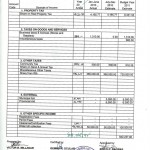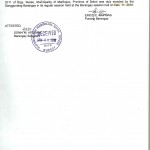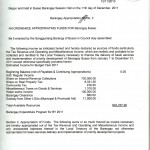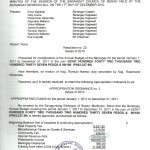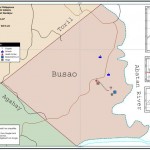BARANGAY CHAIRMAN
Rosario M. Dapiton
BARANGAY KAGAWADS
1. Rosemarie D. Recemilla
2. Carmeth N. Suacillo
3. Marcelino C. Restar
4. Ma. Elena N. Samson
5. Macrina P. Arais
6. Reynaldo L. Millanar
7. Elena B. Macalos
BARANGAY SECRETARY
Sonia M. Apugan
BARANGAY TREASURER
Maria Teresa J. Borcelas
BARANGAY PROFILE:
Name of Barangay: BUSAO
Distance from Poblacion: 7 Kilometers
Total Land Area: 146.08 Hectares
Total Population: 630
Number of Household: 152
Number of Schools (Public): 2
Length of Barangay Roads: 1. 4 Kilometers
Source of Potable Water: Ubujan Spring
Waterworks System: Busao Waterworks
Major Agricultural Product: Banana, Coconut, Rice
Major Source of Livelihood: Employment (government & private), Carpentry
Barangay IRA: PhP 1,692,737.00
Number of BHWs: 3
Number of Day Care Centers: 1
Number of BNS: 1
Number of Tanods: 7
CREATION OF THE BARANGAY BUSAO AND ITS LEGEND:
Barangay Busao was created in 1861. Little is known of when the exact date was it created and by what law was it created yet there were legends how it got its name.
You must hear of such strange creatures as monkey-eating eagles, horrible dinosaurs, terrifying monsters and incredible giants. Well, here’s one account of how the greatest of all giants affected all the lives of all living things which eventually resulted in the annihilation of plant species.
Long time ago, giants were believed to have lived with people. They freely roamed around and lived directly just as people did. It was also known that the strength of one giant was equivalent to the force of one hundred people pooled together.
One day, Ka Macar, the most respected elder in the locality gathered the adults in the neighborhood for a meeting. Ka Macar suggested to his neighbors that in order to be self-sufficient in food, the people must plant root crops, vegetables and cereals besides raising animals for the same purpose.
The idea was widely accepted by the people so they implemented the plan right away. In three months’ time, the plants were already lush and verdant. There was seemingly hope for a bountiful harvest. Everybody was looking forward to more fruitful years ahead.
At about the same time , a giant named Kale, made a nearby cave as his abode. What was so different about from the rest of his kind was that he kept on sleeping inside the cave and come out only when hunger strikes him.
One crazy idea came to Kale’s mind. He thought how easy it would be to feed his stomach by simply depending on the plants and animals raised by the people around for food. He saw that the place was becoming greener and greener.
And no one morning, he came out of his cave and started tasting the plants along his way, only to find out that not all plants were palatable to his taste. However, there was one kind of plant which to him was delicious. The plant belong to a fern family. Its spreading stems were covered with tiny leaves. People used this plant for hog feeds and also for medicine. Natives of the place named the plant “Pusaw” and those plants became giant Kale’s favorite food for breakfast, lunch, and supper.
When the people learned of this happening, they began to worry. They were resigned that they would be outsmarted by the enemy. But they could not afford to lose the versatile Pusaw which was almost eaten up day by day.
And so Ka Macar with his wife Ka Leah called again his neighbors to help solve the problem. A young and dynamic cousin of Ka Macar named Ka Iko hatched the idea of attacking the cave with torches during night time. The neighbors all agreed.
One moonless night, Ka Iko with all the males in the neighboring stormed the gates of the cave with torches. They set the cave entrance on fire. They shouted “Kale, you better come out!!!. Why did you eat up our Pusaw?”
Not a sound could be heard from the cave. So the people continued burning the cave. They gathered all dried wood and leaves and made blazing inferno of the place. The people believed that Kale was frightened and he must have cardiac arrest for the following week the place smelled foul. Kale died inside the cave. So the people rejoiced.
The plant however gradually disappeared with Kale. Even though how much the people cared for the remaining plants, yet it did not survive. The roots were perhaps cared for the remaining plants, yet it did not survive. The roots were perhaps badly affected by the strength of Kale’s Body.
The natives could not help recounting the incident about the loss of their precious Pusaw. The name Pusaw became byword in everybody’s lips until the P in Pusaw slipped to B as years rolled on making it sound Busaw or Busao.

